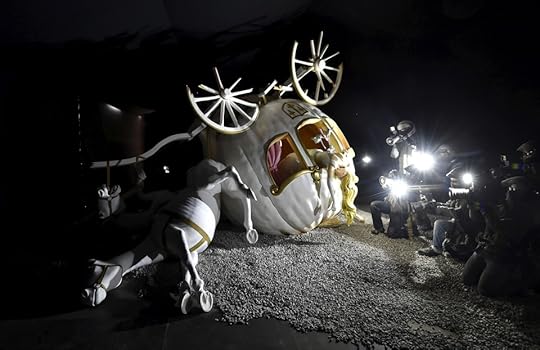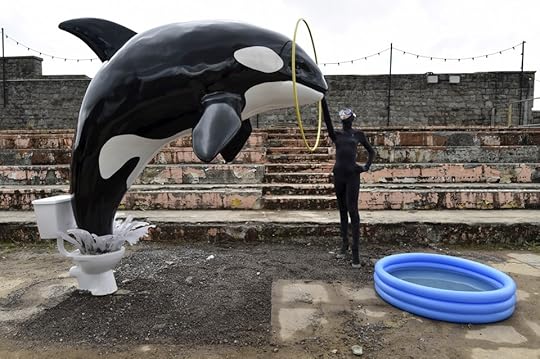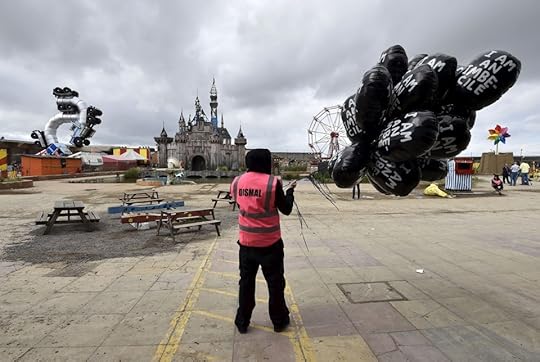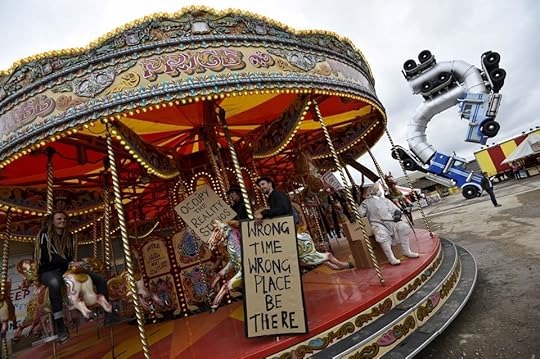Atlantic Monthly Contributors's Blog, page 363
August 20, 2015
A Moment of Grace from Jimmy Carter

The 1970s were overall a terrible and traumatic time, and Jimmy Carter was both their product and their victim. He was their product in that it took an unprecedented national convulsion—turmoil and eventually defeat in Vietnam, the forced resignation of a president—to give a little-known one-term governor of Georgia, and peanut farmer, a chance at national office. He was their victim in that the woes of the late 1970s—gasoline shortages and price spikes, worldwide hyper-inflation that drove the prime interest rate to 21 percent, the dawn of Islamist turmoil in the Middle East, leading to the revolution in Iran—all happened on his watch and dragged him down. Even so, as he points out and as most historians attest, if he had sent one more helicopter on the doomed rescue mission for American hostages in Tehran, he would probably have been re-elected in 1980, and Ronald Reagan might have missed his chance.
The 1970s are so dis-esteemed, and Carter has been so vilified (in counterpoint to the elevation of Reagan), and the entire era is now so long in the past, that many people may wonder how it was that Carter could have become president in the first place.
I think the video of today’s press conference, at which the 90-year-old President Carter discussed the spread of cancer through his body and how he planned to continue his work, will give you a glimpse of what people saw in the man.
Beyond that, it is an extraordinary display of human grace. And humor!
I worked for Jimmy Carter in the campaign and for two years in the White House. I had my differences with and criticisms of him during his troubled time in office, along with support and admiration. I now find it amazing that so many things he did, and tried to do, stand up so well in the long run. The peace that has lasted in the Middle East is the one he willed into existence, between Israel and Egypt.
But even if you disdain his ideas and his works, I suggest watching this performance for its display of intelligence, serenity, and, again, grace, of a sort we all can reflect on.









‘Dismaland’: A Theme Park By Banksy

An anarchy-friendly theme park? A fun day out for the whole family that features book burning, a puppet Jimmy Savile, and political commentary? “Dismaland,” a temporary art installation recently unveiled in the U.K., could only be the work of Banksy, the anonymous street artist whose guerilla artworks frequently sell for six figures at auction despite his best efforts.
Constructed as a decrepit interpretation of the happiest place on earth, and based in the seaside town of Weston-super-Mare, the “bemusement park,” as it’s called, is ironically billed as “the latest addition to our chronic leisure surplus,” as well as “an art show for the 99 percent.” Dismaland, which opened Thursday, features attractions including a grinning Grim Reaper sitting in a bumper car, paparazzi snapping shots of a deceased Cinderella after a pumpkin-carriage crash, and a butcher making lasagna out of carousel horses.
 A sculpture of paparazzi snapping shots of a mangled Cinderella (Toby Melville / Reuters)
A sculpture of paparazzi snapping shots of a mangled Cinderella (Toby Melville / Reuters) Audience participation is encouraged: “A dead princess is only complete when surrounded by gawping crowds with their cameras out or the opportunity to photograph yourself pulling an amazed expression when a killer whale leaps from a toilet,” Banksy told the BBC.
 A sculpture of an orca erupting out of a toilet bowl at Dismaland (Toby Melville / Reuters)
A sculpture of an orca erupting out of a toilet bowl at Dismaland (Toby Melville / Reuters) Built on the site of an abandoned outdoor swimming facility that the artist frequented as a child, Dismaland features politically charged works by Banksy and 58 other artists, including Damien Hirst, Jenny Holzer, and Jimmy Cauty, who built a model village swarming with riot police.
The artist Darren Cullen, who created a pocket money loans shop in the “kid’s enclosure” that offers money to children at the generous interest rate of 5,000 percent, told The Guardian neither he nor the other artists met Banksy during the process of putting together the exhibition. “I only knew the minimum amount before I got here, but it is so cool,” he said. “It is just amazing having this much sarcasm in one place.”
 A Dismaland employee holds balloons that read “I am an imbecile.” (Toby Melville / Reuters)
A Dismaland employee holds balloons that read “I am an imbecile.” (Toby Melville / Reuters) Even though Banksy has insisted the show “was not a swipe at Mickey and co.,” several of his 10 new works, including a distorted Little Mermaid who sits on a rock in the castle’s lagoon, use copyrighted material. Unsurprisingly, “legal representatives of the Walt Disney Corporation” are “strictly prohibited” from entering the park (also banned are spray paint, market pens, and knives).
Other attractions include a daily bonfire kindled by the works of the disgraced peer and crime novelist Jeffrey Archer, a caricaturist who only draws the backs of visitors’ heads, and a riot-control vehicle from Northern Ireland that’s been turned into a children’s slide.
 Park-goers ride the carousel, where a sculpture of a butcher makes lasagna from the horses. (Toby Melville / Reuters)
Park-goers ride the carousel, where a sculpture of a butcher makes lasagna from the horses. (Toby Melville / Reuters) Dismaland is open until September 27 with a limited number of tickets available online. Demand is expected to be very high, especially on Fridays, which are billed to feature performances by musicians including Run the Jewels, Pussy Riot, Massive Attack, and more. It’s highly possible Banksy will be on the premises, even if recognizing him will presumably be a challenge for most attendees.









How Loudspeakers and Balloons Heighten Tension Along the Korean Border

Tensions along the inaptly named “demilitarized zone” on the border between North and South Korea flared up on Thursday, as the two countries exchanged rocket and artillery fire for the first time since 2010. The incident—which caused no injuries—was an escalation in a recent series of incidents along the border. On August 4, the South Korean government accused the North of planting land mines along the border that wounded two South soldiers.
Thursday’s incident also reinforced the uniquely powerful role that propaganda plays in driving the Korean conflict, which has remained unresolved following the 1953 ceasefire that ended the Korean War. Following the land mine injuries earlier this month, the South revived a dormant practice of broadcasting messages through loudspeakers alongside the border, something it had not done in 11 years. The North retaliated in kind, threatening the South with war.
South Koreans also brought back the years-old practice of releasing balloons into the sky. South Korean activists insert messages written in Korean into the tall, cylindrical tubes, and then release them into North Korean territory. Traditionally, these balloons have only a modest effect on their intended audience—North Koreans tend to be suspicious of propaganda messages delivered by non-government actors. The balloons can also contain objects such as DVDs, USB sticks, and even chocolates—giving the isolated northerners a glimpse into the world beyond their borders.
“When North Koreans see high-quality consumer goods produced overseas, they begin to understand that their economic system doesn't really deliver,” Andrei Lankov, a worldwide leader in North Korean expertise, told BBC in 2012 of the benefits of dispatching the balloons.
But opponents of the balloon drops claim that such forms of “psychological warfare” are an unnecessary provocation of the North Korean regime, who regards the drops as an “act of war.” In addition, there’s reason to believe that residents of North Korea are less starved of outside information than before. Increasing numbers of North Koreans regularly traverse the country’s porous border with China and return to their country with smuggled goods like televisions, DVD players, and radios. According to interviews with defectors, North Koreans have even developed a taste for American television shows like Desperate Housewives. Propaganda from the south, may, in some cases, be little more than an unwanted and unneeded intrusion from the outside.
Seoul, for its part, has urged leaflet-distributing activists—some of whom are North Korean defectors themselves—to cease releasing the balloons. But the use of loudspeakers is an indication that the government has no desire to curtail its propaganda efforts entirely.









The Secret Life of Panda Moms

The nation’s capital received its favorite kind of news this week: panda news.
The National Zoo announced Wednesday night that giant panda Mei Xiang, mom to two-year-old and national treasure Bao Bao, may be pregnant, and could give birth as early as next week or early September. The zoo released a sonogram showing what veterinarians believe to be a developing fetus, and its director said everyone there remains “cautiously optimistic.”
The zoo is being cautious for a reason. Breeding captive pandas—and later caring for their offspring—is a difficult and fragile process. In the United States, only two captive pandas have successfully bred naturally: Gao Gao and Bai Yun at the San Diego Zoo. As recently as the 1990s, io9’s Jason G. Goldman wrote last year, only 30 percent of captive giant pandas successfully reproduced, and more than 60 percent of those cubs died in infancy.
Here’s what scientists discovered in their early efforts to naturally breed members of the endangered species, according to Panda International, a nonprofit conservation group:
[Pandas] either lost interest in mating the natural way or simply did not know how… timing is everything—and it is working against them. A female panda has a single estrous cycle once a year, in the spring… and she’s only actually fertile for 24 to 36 hours.
That’s a very small window. Paul Bisceglio described Mei Xiang’s particular breeding experience—a few months before she gave birth to Bao Bao—with Tian Tian, the zoo’s male giant panda, in Smithsonian magazine in 2013:
The two had become rambunctious leading up to the encounter, and spent days staring longingly at one another through the fence that divides their yards… Despite the flirtatious fireworks, though—and while it was the seventh year in a row the two had been put together to mate—the two pandas again failed to copulate. As she has in the past, Mei Xiang flopped on her belly like a pancake when she met with Tian Tian—the opposite of good mating posture, which would have her rigid on all fours—and Tian Tian went about his usual routine of stomping around and standing on her, clueless what to do.
When natural breeding fails, scientists turn to artificial insemination, which has become common in panda breeding facilities around the world. The latest technology allows scientists to track female pandas’ hormones and determine the optimal time to artificially inseminate them with freshly collected or frozen samples from male pandas. In April, Mei Xiang was artificially inseminated with semen collected from a giant panda named Hui Hui, who lives in a conservation center in Wolong, China, and another sample from Tian Tian. Her two cubs, Bao Bao and 10-year-old Tai Shan, who lives in China, are both products of artificial insemination.
Detecting pregnancy in pandas isn’t easy, either. The tiny fetuses are difficult to spot during ultrasound procedures. Pandas can experience something called embryonic diapause, in which an embryo becomes fertilized but takes some time to implant in the uterine wall and begin to develop. This can prolong the usual gestation period of 50 days to more than 160 days, according to Panda International. Pandas can also experience “pseudopregnancy,” in which female pandas exhibit the standard signs of being pregnant—they build nests, sleep more, eat less—but are not actually pregnant. When pandas become pregnant, they risk resorbing or miscarrying the fetus—“a substantial possibility” for Mei Xiang, the National Zoo said on Wednesday.
Humans also intervene in the care of newborn panda cubs, which are born blind, hairless and 1/900th the size of its mother—in other words, helpless. Pandas often give birth to twins, but lack the energy to care for two cubs. In the wild, that means one cub is left to die. Not so at breeding centers, where researchers help the mother take care of both. And some caretakers can get pretty creative, as the BBC reported about one Chinese facility in 2010:
Whenever a cub was abandoned after birth, keepers at the Chengdu centre swiftly moved it to an incubator. Panda mothers were tricked into caring for twins as staff stealthily rotated them between their mother and the incubators. The survival rate of cubs rose to 98 percent through this combination of maternal care and artificial support.
At the National Zoo, Mei Xiang will be receiving round-the-clock attention from zookeepers, veterinarians, and scientists for the next few weeks, as Baby Panda Watch 2015 kicks into high gear. And she’ll be getting lots of attention from outside of her enclosure, too, thanks to the zoo’s infamous panda cam.









The Latest Victim of the Greek Crisis
 Greek Prime Minister Alexis Tsipras stunned Europe Thursday by announcing his resignation and calling for snap elections next month.
Greek Prime Minister Alexis Tsipras stunned Europe Thursday by announcing his resignation and calling for snap elections next month. In a televised address to the nation, Tsipras said he would submit his resignation to the president—a move that would trigger elections—and he said the public would decide “with your vote whether we made the right choice” on the massive bailout deal.
Shortly, I will submit my resignation, as well as the resignation of my Government, to the President of the Republic. #Greece
— Alexis Tsipras (@tsipras_eu) August 20, 2015
The popular mandate I received on January 25th has run its course. Now, the sovereign people of #Greece must weigh in.
— Alexis Tsipras (@tsipras_eu) August 20, 2015
Last week, Tsipras successfully navigated the controversial bailout through his country’s parliament. But he faced backlash from members of his own far-left Syriza Party who felt the package was against Greece’s interests. Nearly a third of the party’s members either voted against the deal or abstained.
The package—about $96 billion over three years—calls for tax increases, cuts to Greece’s vast public sector, and pension reforms. Greece’s creditors—the European Union, the European Central Bank, and the International Monetary Fund—had insisted on the terms without which Greece would have run out of money and faced an exit from the euro zone. But these were painful concessions for a country that has not recovered from the 2008 global recession.
Tsipras, who was elected in January, was widely expected to call for a vote of confidence in parliament, but the rebellion within Syriza meant he would have likely fallen short of the 120 votes he needed in the 300-seat chamber. Calling for elections, which news reports say could be held as early as September 20, allows him to come back possibly with more support to implement the bailout package. (For an account of how much Greece owes, when, and to whom, please see this interactive from The Wall Street Journal).
The Guardian adds that Greece will be run by a caretaker government until the election is held. The favorite to lead that government is Vassiliki Thanou-Christophilou, the president of the country’s supreme court. She would be Greece’s first female prime minister.
On Thursday, Greece received the equivalent of $14.5 billion from its creditors—the first installment of the bailout cash. The money allowed it to repay the ECB.









A Trump-Inspired Hate Crime in Boston

The impact of Donald Trump’s anti-immigrant broadsides appears to have veered dangerously far off the presidential campaign trail.
Police in Boston say that one of two brothers who allegedly beat a homeless Hispanic man cited Trump’s message on immigration as a motivation for their attack. “Donald Trump was right, all these illegals need to be deported,” Scott Leader, 38, told officers, according to a police report cited by The Boston Globe.
Leader and his brother, Steve, were arrested and charged with multiple assault charges after police said they urinated on and then assaulted a 58-year-old homeless man they found sleeping outside a T-station as they walked home from a Red Sox game. They allegedly beat him with a metal pole, breaking his nose and causing other injuries. According to the Globe, Scott Leader told police it was OK to assault the man because he was Hispanic and homeless. Both men, who have extensive criminal records, pleaded not guilty and said the homeless man started the confrontation.
Officials in Boston immediately denounced the attack. But Trump, who has made no apology for suggesting some Mexican immigrants were “rapists” and calling for their mass deportation, appeared to brush off the incident when he was asked about it while campaigning Wednesday in New Hampshire. “I think that would be a shame,” he said, according to The Boston Herald, in reference to the report. He said he hadn’t heard about the incident but then defended his most ardent supporters as “passionate.”
I will say, the people that are following me are very passionate. They love this country. They want this country to be great again. But they are very passionate. I will say that.
For Latino leaders who repeatedly denounced Trump’s rhetoric against undocumented immigrants, the most disturbing part of the attack in Boston was how unsurprising it was. “It’s a pattern that we have seen over the last decade in the nation with enforcement only policies and this anti-immigrant rhetoric,” said Hector Sanchez, the chairman of the National Hispanic Leadership Agenda, in a phone interview, “I was not surprised.”
Sanchez said he has repeatedly warned that Trump’s statements, which have been laughed off as clownish in some quarters, are taken far more seriously in the Latino community. “When Trump is having this kind of anti-Latino and anti-immigrant language, he’s not only a clown talking in general, his language has a direct impact in the quality of life of Latinos,” he said. Sanchez said he believed that a 50 percent rise in hate crimes against Hispanics over the last five years is “directly correlated” to anti-immigrant rhetoric from conservatives. Before Trump’s emergence in the last few months, inflammatory statements from Republican members of Congress like Steve King and Louie Gohmert made national headlines.
Frank Sharry, the executive director of America’s Voice, called Trump’s response to the attack “morally bankrupt.”
This pattern of hateful rhetoric has officially passed the of point of extremist words and has turned into alarming action. This is more than just bad politics. When political debate encourages an atmosphere where hateful actions and hurtful rhetoric get mainstreamed, it’s bad for the country.
Yet with Trump’s rivals in the Republican field responding to his rise by running to the right on immigration, there seems to be little that Latino leaders can do beside denounce the party and promise retribution at the polls next year. “Unfortunately, a lot of those extremist views are now reflective of the Republican Party,” Sanchez said. Will the outrage of the hate-fueled attack in Boston prompt the GOP to take on Trump more directly? Perhaps. But if Trump’s establishment-be-damned campaign strategy is a guide, it might not do much good.









With Documentary Now!, the Joke’s in the Details

The most admirable thing about IFC’s new spoof series Documentary Now! is also the element that makes its premise so challenging for viewers—its utter devotion to the form it’s sending up. Starring Bill Hader and Fred Armisen and produced by their former Saturday Night Live co-star Seth Meyers, the series astutely satirizes some of the most famous examples of the documentary form, from its earliest days (Nanook of the North) to its most notorious moments (Grey Gardens). Can you laugh if you’re not aware of the source material? Certainly, but these are no SNL sketches—the gag plays out over 22 finely crafted minutes, and easy punchlines are nowhere to be found.
Related Story
What Seth Meyers Is Doing Differently
Armisen described the show as “a celebration” of the works it’s satirizing at a panel discussion about the series hosted Tuesday by The Atlantic and IFC. Since breaking into comedy programming with Armisen’s sketch show Portlandia in 2011, the network has become a hub for alternative humor that appeals to niche audiences, and Documentary Now! epitomizes that brand, taking the “mockumentary” genre in the opposite direction from goofier entries like Borat or the sitcom framework employed by The Office. The jokes are in the details, and series director Rhys Thomas (another SNL alum) makes sure to get them exactly right.
That’s not to say the initial two entries are lacking in punchlines. The first (the aforementioned Grey Gardens spoof, titled Sandy Passage), debuting Thursday at 10 p.m., features one of the best on-screen pratfalls Hader has ever executed. But it’s safe to say that not every Stefon fan has seen the Maysles Brothers’ famous 1975 examination of the lives of a reclusive mother and daughter connected to the Bouvier family. There’s plenty to be enjoyed from scenes of Armisen and Hader in drag, alternatively shouting and singing at each other, but fans of the original film will probably derive extra laughs from the episode’s core aesthetic, and the shots and cuts that perfectly mimic the Maysles’ approach.
The second episode, a send-up of Vice News called Dronez, affirms the effort Thomas and his crew have made to mirror the style of each entry’s target. “We'd reach out to filmmakers as much as we can, find out what lenses they used, what film stocks,” Thomas said. “We have a very accurate film grain applied. We really try to pay attention to every detail.” At SNL, Thomas was responsible for some of the show’s most on-target visual parodies, like the fake Wes Anderson horror film, “The Midnight Coterie of Sinister Intruders,” that aped the director’s style so well, it felt less like an imitation and more like the real thing.
Documentary Now! goes for the same approach, and even contracted Helen Mirren (apparently a big Portlandia fan) to introduce the series’s six episodes in order to endow it with an extra degree of prestige. It’s a style of parody IFC has attempted before in the recent Will Ferrell/Michael K. Williams/Kristin Wiig spoof The Spoils Before Dying, which mocked the big-budget premium cable miniseries, but that show made sure to draw attention to its absurdities, even having one of its cast members be played by a mannequin. Documentary Now! is more in the old-school mockumentary style: It never quite wants to let on that there’s any funny business afoot.
“Everything we used as a jumping off point was something we loved,” Meyers said. “We always wanted these things to be companions.”“Everything we used as a jumping off point was something we loved,” Meyers said. “We always wanted these things to be companions … We tried very hard for all of them to have beginnings, middles, and ends.” Source material that already had a comic tone, like the work of Michael Moore, was off-limits, as was anything “anybody had nailed before,” like This is Spinal Tap or the guerrilla-style approach of Sacha Baron Cohen, who splices real, unwitting participants into his films.
“I love that you can make a show that’s funny but also really cinematic, as a film-lover,” Hader added, noting that in his early takes making Sandy Passage, he would try to go for the laugh, tilting his character’s antics towards slapstick. Thomas encouraged a more emotional approach, and it shows in the episode: The joke, if anything, seems to derive from the absurdity of the source material, that Armisen and Hader barely need to heighten their takes on Big and Little Edie (nor wear much makeup) to replicate the strange, natural comedic chemistry the original pair had.
Dronez takes a more aggressively silly approach, following several hipster journalists in their efforts to track down a Mexican drug lord, but it fits with the self-aggrandizing model of HBO’s Vice News series, which often seems to spend a little too much time with the filmmakers rather than their subjects. Following in subsequent episodes are the Nanook of the North parody and a crime drama in the style of Errol Morris’s The Thin Blue Line, scripted by the great John Mulaney (yet another former SNL staffer), whose stand-up comedy bits suggest a strong interest in the true-crime genre. In true IFC style, the show has already received a second season order, from a network that holds on to its stars as much as possible—its talk show parody Comedy Bang! Bang! received a 40-episode order for its fourth season and is still going strong.
Like any other IFC show, Documentary Now! won’t be for everyone, but there’s something refreshing about its commitment to the style of its source material. With the success of The Office in 2005, the mockumentary became a sitcom style that encouraged a glut of single-camera comedies that punctuated scenes with an easy joke from a talking head—a format mimicked by hits like Parks & Recreation and Modern Family. The laugh track of the multi-camera sitcom wasn’t present, but its rhythms could be retained. The only problem was that the “show-within-a-show” for these series became more and more nebulous—it was hard to imagine just who the cast of Modern Family were addressing every week. Documentary Now! is a comedy first and foremost, but it never forgets that it’s parodying filmmaking rather than real life.









Jimmy Carter on His Cancer Diagnosis

Jimmy Carter is ready for his first cancer treatment.
“I’m perfectly at ease with whatever comes,” the former president told reporters Thursday during a press conference at the Carter Center in Atlanta. Carter announced last week that doctors discovered a small mass on his liver during a recent surgery, and that it was cancer.
On Thursday, Carter, 90, revealed more: that a scan had found four “very small spots” on his brain, that these spots were diagnosed as melanoma, and that he will undergo radiation treatment on his brain in just a few hours.
The former president spoke candidly for nearly 40 minutes, describing in detail what physicians have planned. Carter said he will receive four treatments scheduled at three-week intervals, and undergo more scans to search for signs of cancer in other parts of his body. Wearing a dark jacket and red tie with white polka dots, Carter appeared jovial, smiling as reporters asked questions and only stopping to take a sip of water a half hour in. The former president sounded like he was describing a new project by his Carter Center, and not a cancer diagnosis. He referred to what’s next for him as “a new adventure.”
“You know, I have had a wonderful life,” Carter said. “I have had an exciting and adventurous and gratifying existence.”
When he first learned of the melanoma in his brain, Carter said he thought he “had just a few weeks left.” But he remained in good spirits. “I didn’t go into an attitude of much despair or anger or anything like that,” he said. “I was just completely at ease.”
The reaction to last week’s announcement has been “emotional,” he said. Supporters have sent him peach pie, a classic summer dessert in his home state of Georgia. President Obama, former presidents George H. W. Bush and Bill Clinton, Vice President Joe Biden, and Secretary of State John Kerry all called him—the “first time they’ve called me in a long time,” Carter said, laughing.
When asked for the accomplishment he feels most proud of, Carter said it was marrying Rosalynn, his wife of 69 years. “That’s the pinnacle of my life,” he said. Serving as president was the pinnacle of his political career, Carter said, but his work through his eponymous nonprofit organization has been “personally more gratifying.”
Much of that work will be put on hold. Carter said he will reduce his work at the center and as a professor at Emory University “fairly dramatically.” As for his annual trip to Nepal with Habitat for Humanity in November, Carter said he would have to wait and see. The trip would be the 33rd time he has traveled there to help build homes.
And what about his regrets? “I wish I had sent one more helicopter to get the hostages and we would have rescued them,” he said, referring to the Iranian hostage crisis between 1979 and 1981, and drawing laughter from the room. “And I would have been re-elected.”








The Investigation Into the Bangkok Bomb Attack

Updated on August 20 at 12:21 p.m.
Thai officials say Monday’s deadly blast at a popular shrine in Bangkok was not the work of international terrorists, even though they described the main suspect in the bombing as a “foreign man.”
“Security agencies have collaborated with intelligence agencies from allied countries and have come to the same preliminary conclusion that the incident is unlikely to be linked to international terrorism,” military spokesman Col. Winthai Suvaree said in a televised statement.
But he later told The Associated Press it was too soon to draw any conclusions.
“We still have to investigate in more detail,” he said.
Officials released security footage this week that showed a man in a yellow T-shirt and shorts walking near Bangkok’s Erawan shrine carrying a backpack. He is then seen sitting on a bench, removing his backpack and walking off. The explosion occurred about 15 minutes later, killing 20 people and injuring more than 100.
On Wednesday, police issued an arrest warrant for the man, whom they described as tall and “foreign." They said he had a prominent nose, thick lips, and a fair complexion.
A $28,000 reward for information leading to his arrest was increased Thursday to $56,000.
Police said Wednesday two other men in the video—one in a red T-shirt and the other in white—were suspects. On Thursday, the pair voluntarily gave themselves up to police, denying they had anything to do with the blast. Police cleared the pair—a Chinese man and his Thai guide—on Thursday.
The dead included six Thais, four Chinese nationals, four Malaysians, two people from Hong Kong, an Indonesian and a Singaporean. Suvaree denied that Chinese nationals, the largest group of foreign tourists to Thailand, were deliberately targeted.
No on has claimed responsibility for the attack. On Monday, soon after the blast, Thai officials suggested the country’s opposition was behind the attack. But officials have backed away from that assertion. Although political unrest is common in Thailand, attacks of this scale are not. Thai officials rejected the idea that the attack was carried out by Muslim rebels in the south of the country.









The Retrial of a Texas Man Imprisoned Despite an Overturned Conviction

Jerry Hartfield, 59, has been in prison since 1977 even though his original murder conviction was overturned in 1980. On Wednesday, a Texas jury found him guilty of the crime for a second time.
In 1977, a jury convicted Hartfield, who is black, of the 1976 rape and murder of Eunice Lowe, a white 55-year-old bus-station ticket agent in Bay City, Texas. Three years later, Texas’s highest criminal appeals court overturned the conviction, citing jury selection issues, and ordered a retrial—an order the prosecution fought for years. Before that retrial began, however, then-Texas Governor Mark White commuted Hartfield’s death sentence to life imprisonment in 1983.
There was only one catch: Because Hartfield’s original conviction had been vacated, he legally had no death sentence for the governor to commute. But since no one realized this at the time, or for decades afterward, Hartfield stayed in prison and served the commuted life sentence without retrial. My colleague Andrew Cohen described how every part of the criminal-justice system failed Hartfield when he wrote about the case in 2013:
Texas prosecutors thought that the governor's commutation resolved the issue, at least until someone challenged the commutation for failing to supersede the mandate of reversal. The state judges in 1983 reckoned that the mandate had been issued, and that if the case weren't properly resolved they would soon hear about it from prosecutors or defense counsel. And Hartfield's lawyer says that he stopped representing his client when the commutation came through. Everyone dropped the ball on Hartfield, who after 32 years in prison still has never received a parole hearing even though he's long been entitled to one.
Hartfield, who reportedly has an IQ of 51, did not realize he was serving a life sentence until a jailhouse lawyer discovered the error in 2006. When Hartfield petitioned for release that year, prosecutors fought it, and state courts refused his request. But in June 2013, the Texas Court of Criminal Appeals ruled that Hartfield was indeed in prison without a sentence. Prosecutors then announced their intention to retry him—more than three decades after his original sentence was tossed out—and kept him in prison until then.
In 2014, a state judge ruled that Hartfield’s Sixth Amendment right to a speedy trial had not been violated during his 35-year incarceration because he had not sought out a new trial. His new trial began earlier this month, and he was found guilty of the murder Wednesday. As The Guardian notes, holding a retrial for a murder that took place almost four decades ago posed major challenges:
Hartfield’s attorneys said the murder weapon could not be found and Lowe’s car no longer existed. Many of the more than 125 people on the prosecution’s witness list are dead or could not be found and some witness testimony from the 1977 trial was read into the retrial. Wooten said that meant he could not cross-examine them, raising questions about the fairness of the retrial.
The Associated Press reports jurors chose not to convict Hartfield of capital murder, which would have led to an automatic life sentence. He could not be resentenced to death because the Supreme Court abolished the death penalty for the intellectually disabled in 2002. The de facto minimum IQ for execution is 70; Hartfield’s IQ is well below that. He instead faces five to 99 years in prison, though he may be immediately eligible for parole if his 35 years of incarceration are counted as time served.









Atlantic Monthly Contributors's Blog
- Atlantic Monthly Contributors's profile
- 1 follower



